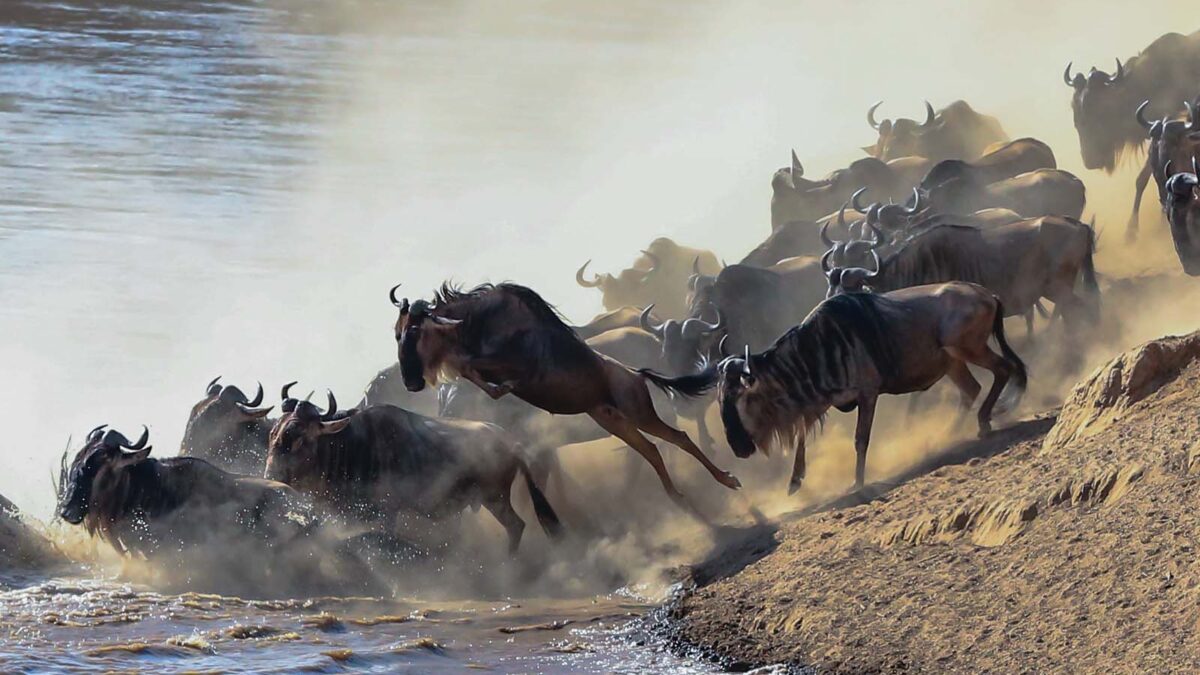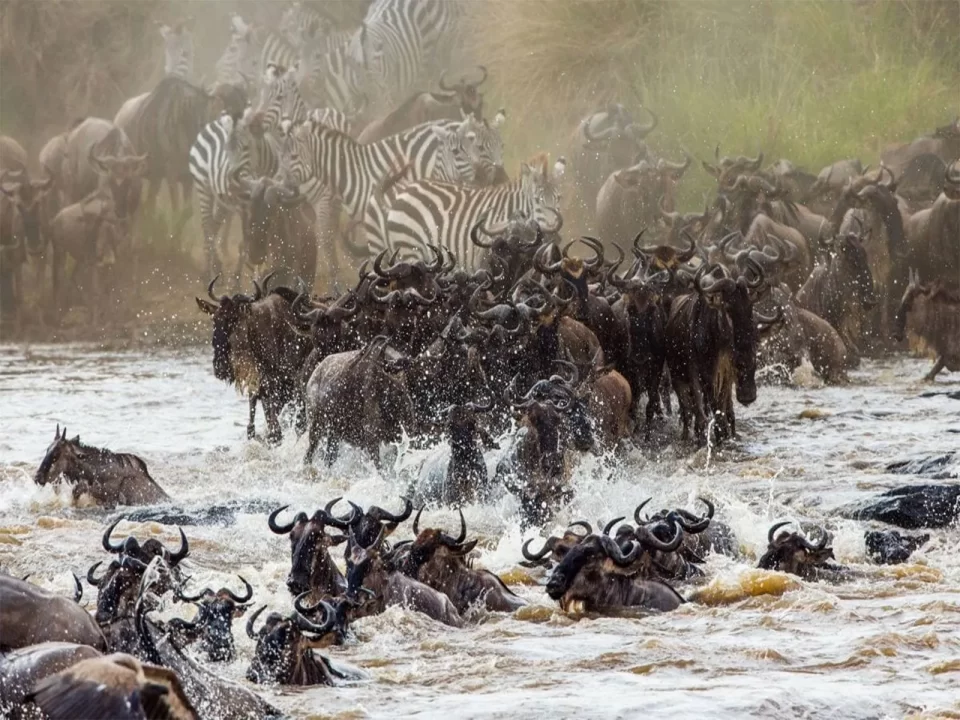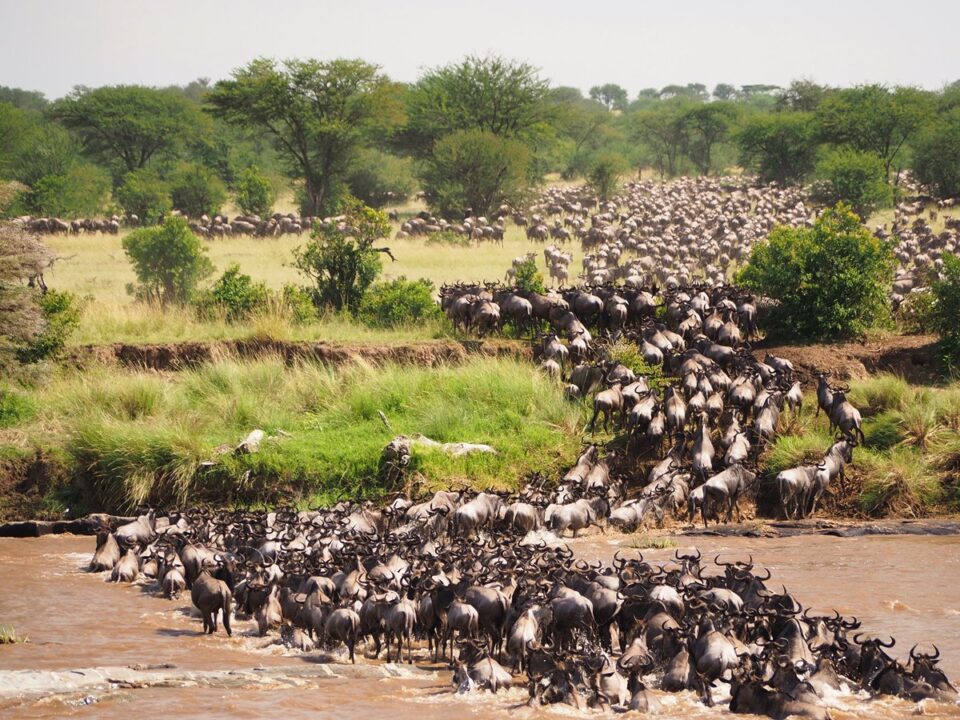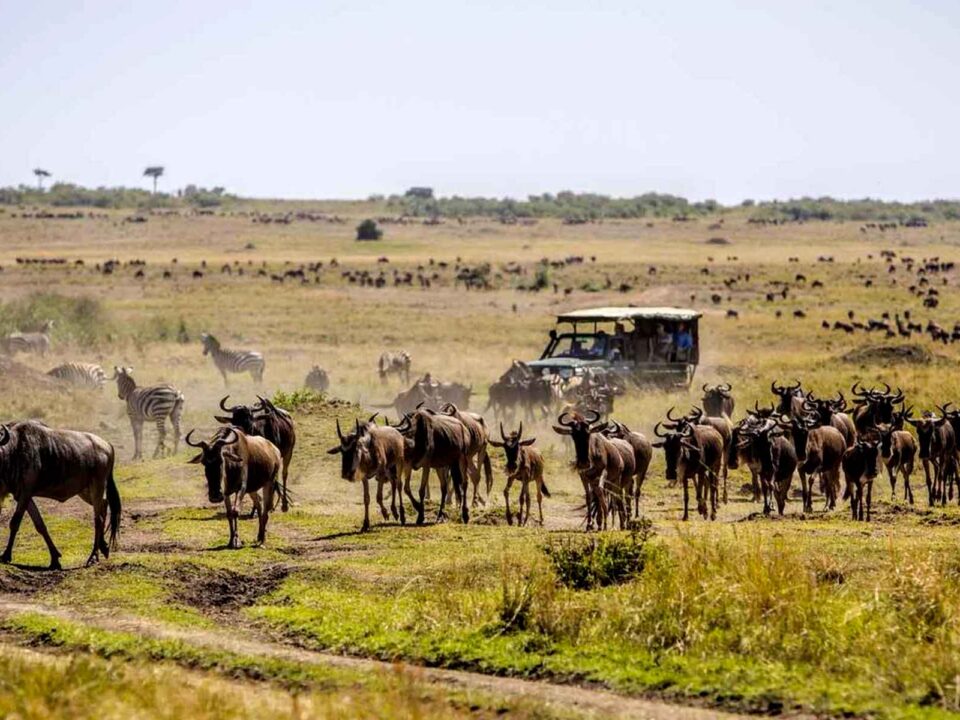Kenya & Tanzania Wildebeest Migration Safari

Booking Mount Nyiragongo Hike and Trek
October 7, 2023
Hiking Mountain Mikeno in DR. Congo
October 7, 2023Experience the Unforgettable: Kenya & Tanzania Wildebeest Migration Safari
Embark on a remarkable journey with Trek Africa Expeditions as your premier ground handler, guiding you through an all-inclusive Kenya wildebeest migration safari. For years, the epic wildebeest migration, spanning the sweeping landscapes from the Masai Mara plains to the Serengeti plains in Tanzania, has captivated the hearts of travelers exploring Kenya and Tanzania.
It’s essential to note that this awe-inspiring spectacle of nature unfolds from early June to late October. Given the high demand for services around Serengeti and Masai Mara during this time, travelers are encouraged to secure their safari well in advance. This ensures access to premier sector accommodations, affording the best views of the wildebeest migration in Kenya or Tanzania. For comprehensive information and reservations, please contact the team of expert consultants at Trek Africa Expeditions, dedicated to organizing unforgettable safaris to Kenya and Tanzania.
Wildebeest Facts: Your Wildlife Guide
Physical Characteristics
Wildebeests, also known as gnus, are imposing large antelopes characterized by their shoulder heights ranging from 45 to 55 inches and a weight of 300 to 600 pounds. Their length spans between 5 and 8 feet, with tails measuring 14 to 22 inches. This species earned its name, “wildebeest,” from Dutch settlers in South Africa, which translates to “wild beast.” This nomenclature reflects their untamed appearance and robust nature.
Wildebeests possess elongated, rectangular-shaped heads, featuring lengthy horns that curve outward from the base of their skulls, forming curved semicircles pointing slightly backward. In adult males, these horns display distinctive embossing. Coloration varies among the different subspecies, ranging from slate grey to dark brown, with males typically sporting darker hues than females.
These animals are covered in short hair, accentuated by black vertical stripes of longer hair on their backs. Their bodies appear somewhat disproportionate, characterized by a robust front, slender hindquarters, and spindly legs.
Habitat and Feeding Habits
Wildebeests thrive in regions that strike a balance between being neither excessively wet nor overly dry. Their habitat ranges from the Equator to the southern tip of South Africa. The blue wildebeest, also known as the brindled gnu, inhabits regions from Kenya to northern South Africa. They favor dense bushlands, open grasslands, and woodland floodplains within the southern savannah.
These creatures are strictly grazers, showing a preference for sweet, sturdy grasses. Such grasses often flourish in areas recently ravaged by fires, where tall, coarse brush has been cleared, making room for fresh vegetation growth. Additionally, wildebeests trail herds of other grazers that feed on drier, taller grasses. In addition to grasses, they consume succulent plants and browse on Karoo bushes. Their grazing activities commence shortly after sunrise, with a brief rest at midday, followed by continued feeding until sunset. Wildebeests require a regular source of water.
Behaviors
Wildebeests are highly social and territorial animals. Female wildebeests and their offspring form small herds, often with overlapping territories. Male wildebeests leave their herds after approximately one year and join bachelor herds. Around 4 or 5 years of age, males become profoundly territorial and depart from the bachelor herds. When neighboring bulls encounter each other at the boundaries of their territories, they engage in a series of ritualized behaviors, including bucking, snorting, pawing at the ground, fighting, and emitting a deep croaking grunt, resembling that of a frog. This confrontation culminates in the wildebeests positioning themselves on their knees, foreheads to the ground, poised for combat. The bulls then advance, locking heads and horns, although serious injuries are rare. Wildebeests are in constant motion, day and night, as they search for water sources and preferred grazing grounds. They typically migrate in lengthy single-file columns, covering substantial distances at a leisurely rocking gallop, although they can accelerate when provoked. Various animals, such as Thomson’s gazelles, zebras, and even predators, often trail the moving wildebeest herds. The frequency of a herd’s movement and the number of females within it are influenced by various environmental factors, such as the quantity of rainfall and the quality of dry season pastures.
The Migration
Annually, wildebeests in the Serengeti National Park and the Masai Mara National Reserve embark on a migratory journey covering approximately 500 to 1,000 miles. Following the birth of calves in January and February, the migration commences in the Southeastern Serengeti. They traverse the short-grass plains, making their way toward Lake Victoria in the west. Subsequently, they navigate open woodlands, curving northward en route to the Masai Mara. Eventually, they change direction, heading south toward their original starting point. This journey is marked by unwavering determination, even during river crossings, which result in many casualties, injuries, or losses due to the sheer number of wildebeests.
Predators
Wildebeests are highly coveted prey for both spotted hyenas and lions. Despite their inability to blend in effectively, they do benefit from the protection offered by large herds. Additionally, crocodiles pose a significant threat to wildebeests during their river crossings on the migration route.
Reproduction
The onset of the mating season, known as the rut, is synchronized with the full moon. Territorial males, however, are consistently prepared for mating. During the breeding season, small breeding clusters, comprising approximately 150 wildebeests, form within the larger herds. Within these groupings, the five or six most dominant bulls establish and safeguard territories for the cows to pass through. Bulls engage in displays of bucking and prancing within their territories, marking them through urination, defecation, and the secretion of specific glands on the ground. Secretions emanate from the interdigital and preorbital glands and are spread when bulls paw the ground and rub it with their heads.
When bulls encounter other wildebeests, they acknowledge each other with a rocking canter. If they encounter a cow, the bull endeavors to mount or herd her. If the cow remains calm, the bull may engage in mating, typically occurring approximately twice per minute. If a cow’s herd is on the move, she may cross paths with numerous bulls throughout the day. If she is in estrus, a bull will remain close to her side.
Throughout the mating season, wildebeests exhibit heightened herding behaviors, marked by fights and frequent vocalizations. An aroused bull strives to herd as many cows as possible and may forego sleep and food when a receptive female is nearby. Female wildebeests typically attain sexual maturity at 16 months, although mating often occurs around 28 months. Their high fertility rate is due, in part, to the fact that their peak breeding season coincides with the conclusion of the rainy season, ensuring favorable conditions for nurturing offspring. Gestation lasts between 8 and 8.5 months, with wildebeests unique in that they calve within a concentrated time frame, primarily at the end of the rainy season or the beginning of the peak rainy season.
Female wildebeests give birth to a single calf within the midst of the herd, rather than seeking isolated locations, as many antelope species do. Remarkably, around 80% of females within a herd deliver within the same two to three weeks. The abundance of calves enhances their chances of survival during the vulnerable initial weeks of life. Upon birth, the mother immediately begins licking her calf. In just six minutes, the calf is able to stand and seeks to nurse. It is crucial for the mother to remain close to her newborn for the first two days, ensuring that the calf forms a strong bond, which commences with the initial suckling.
Newborns exhibit a yellowish-brown hue, transitioning to adult coloration at around two months of age. Although a calf begins grazing on grass after approximately 10 days, it continues to suckle from its mother for a minimum of four months. Even after weaning, a calf remains with its mother until the arrival of the next year’s newborn. Typically, young females continue to inhabit the same herds as their mothers, while males are sent away. At eight months, young wildebeests depart from their mothers and form peer groups.
Best Time for Kenya & Tanzania Wildebeest Migration Safari
Now equipped with an understanding of the Great Migration’s intricacies, your ideal time to embark on this unforgettable journey depends solely on the specific events you wish to witness. Keep in mind that the Serengeti and Masai Mara boast an abundance of wildlife and expansive landscapes, making them exceptional safari destinations throughout the year.
Key Facts to Remember
- The primary bulk of the Migration occurs in the Serengeti.
- This migration unfolds year-round, forming a circular route.
- River crossings cannot be precisely predicted but generally transpire between May and September.
- The wildebeests stretch across vast expanses, with both leaders and stragglers.
- For the best chance of witnessing a river crossing, consider dedicating an entire day to a location where the wildebeests have amassed. If you are an avid photographer, note that your prime opportunities may arise around midday when the sun and glare are at their harshest, so prepare accordingly.




